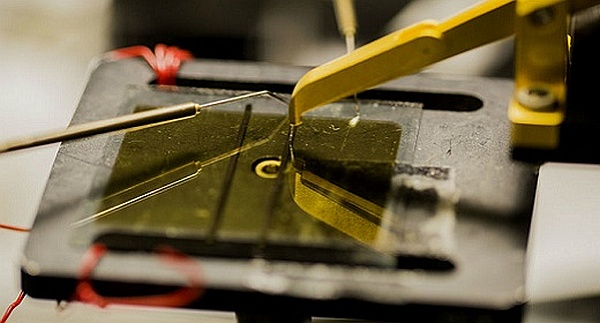New Research Brings Us Closer to Cheap, Transparent, Organic Solar Cells
- Details
- Written by Vanessa Bates Ramirez:

The age of fossil fuels is coming to an end, and the age of renewable energy has dawned—or, it will be dawning soon. In 2014 the World Bank estimated that over 80 percent of the world’s energy came from fossil fuels. That figure is set to drop as countries adopt ambitious goals to move towards solar, wind, and other renewable energy sources.
The European Union has set a target of obtaining 20 percent of its energy from renewables by 2020 and 27 percent by 2030 (it’s currently at 17 percent). Similarly, China set a target of 20 percent renewables by 2030.
While it might be possible to meet these targets with current technology, it certainly wouldn’t be easy, nor cheap. To make renewables a widespread, affordable reality, the way we produce, transfer, and store their energy needs to get better.
A study published last week in Nature by University of Michigan researchers shows potential for a significant advance in solar energy production. The researchers were able to get electrons to travel not only farther than they ever had before, but farther than was even thought possible in the materials used to make organic solar cells.
Organic vs. Inorganic
The vast majority of solar panels in use today are inorganic and silicon-based. They’re more efficient (the current record stands at 26.6 percent efficiency, reached in Japan in 2016) and have a longer lifespan than organics, but they’re also much more expensive to manufacture.
Organic solar cells, on the other hand, are made of polymers, most commonly plastic. This means they can be assembled using existing polymer processing technologies, which makes them cheap to produce—but their efficiency is half that of inorganics at 13.1 percent.
In other words, you’ll get double the energy from a silicon-based cell than you will from a polymer-based cell of the same size. This is unfortunate, because besides being lower-cost, organic cells are also thin, flexible, and transparent. That means they can be unobtrusively applied to pretty much anything—namely, for example, to the 5 to 7 billion square meters of glass surface that exist in the US alone.
Solar Energy 101
To understand why the U of M team’s research is significant, it helps to first understand how solar panels work.
As photons from the sun hit the atoms in a solar cell, the atoms’ electrons are dislodged and begin to move between atoms, producing an electric current. The cells contain a built-in electric field that forces the freed electrons to flow in one direction. Adding metal contacts to the cell allows this current to be drawn off for external use.
Silicon has tightly-bound atomic networks that make it easy for electrons to travel through the material, hence its higher conductivity and efficiency. Organic materials have loosely-bound molecules, which can trap electrons, hence their lower conductivity and efficiency.
What Happened
The U of M team discovered that a thin layer of fullerene molecules, which are made of carbon and are also called Buckyballs, can enable electrons to travel up to several centimeters from the atom they’re knocked off of upon interaction with a photon. It doesn’t sound like much, but it’s an incredible increase from the few hundred nanometers electrons typically travel in organic cells.
The researchers layered a thin film of fullerenes onto an organic cell’s power-producing layer, then added an additional layer to prevent the electrons from escaping. They found that the electrons traveled freely through the material, including outside the power-generating area of the cell. They determined that the fullerene layer formed an ‘energy well,’ a low-energy area that prevented the negatively-charged electrons from recombining with the positive charges left behind in the power-producing layer.
“You can imagine an energy well as sort of a canyon—electrons fall into it and can’t get back out,” said Caleb Cobourn, a graduate researcher in the U of M physics department and an author on the study. “So they continue to move freely in the fullerene layer instead of recombining in the power-producing layer, as they normally would. It’s like a massive antenna that can collect an electron charge from anywhere in the device.”
Why It Matters
The implications of the discovery for solar power are that freely-moving, farther-traveling electrons in organic semiconductors could enable manufacturers to shrink solar cells’ conductive electrode into an invisible grid, resulting in transparent cells that could be used on glass surfaces.
Stephen Forrest, the Michigan engineering professor who led the research, did make it clear that widespread use of his team’s discovery in solar cells is theoretical at this point. But he also noted the discovery’s larger implications for understanding and exploiting the properties of organic semiconductors.
“This discovery essentially gives us a new knob to turn as we design organic solar cells and other organic semiconductor devices,” said Quinn Burlingame, a U of M graduate researcher and author of the study. “The possibility of long-range electron transport opens up a lot of new possibilities in device architecture.”
Vanessa Bates Ramirez: Vanessa is associate editor of Singularity Hub. She's interested in renewable energy, health and medicine, international development, and countless other topics. When she's not reading or writing you can usually find her outdoors, in water, or on a plane.
Liked this article? Dive deeper into personal growth and wellness! Check out CrystalWind.ca for spiritual wisdom or explore AromaWorx.ca for natural well-being tips. Spread the positivity—share this with friends on their happiness journey!
Let’s Chat! Drop Your Thoughts Below! ![]()
Latest Articles
Dive into the Mystical World of the Crystal Wind Oracle Deck!
Get All the Enchanting Details Now!
NEW Expanded Boxed Edition!
Now with 58 Cards for Richer Wisdom!
Imagine a world of inspiration and healing, free for all—made possible by YOU!
Donate Now—Ignite the Magic at CrystalWind.ca!

Epilepsy - Finding A Cure
Your donation can make a difference!
Help us find a cure – donate now!
Unlock Your Light: Join Lightworkers Worldwide on CrystalWind.ca!
Follow Us!
Featured This Month
Crystals for Virgo
As the warmth of summer begins to soften into the crispness of autumn, the Sun... Read more
Sweet Violet
Sweet Violet Faithfulness and modesty. “I will always be true to you.” Helps... Read more
Sun in Virgo
An Overview of Sun Sign Characteristics for Virgo Virgo is guided by Mercur... Read more
Peridot: The Healer's Stone
Peridot has been used as a Power Stone for centuries. Peridot fosters emotio... Read more
The Vine: September 2nd - September 29th
The Autumnal Equinox ( Alban Elfed ) Celtic Symbol : The White Swan Read more
Watermelon Tourmaline
Synonym: Rainbow Tourmaline The watermelon tourmaline is a rare variety t... Read more
Virgo Mythology
The Virgo Myth In all of constellation mythology, few legends are as misund... Read more
Mabon in Modern Times: Fresh Takes on the Au…
The Mabon season begins somewhere around the 21st-22nd of September and cont... Read more
Mabon Magic: Ideas For Fall Decoration And R…
Welcome (almost!) to Fall! We’re turning the Great Wheel once again, toward ... Read more































































































































































